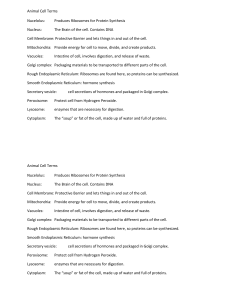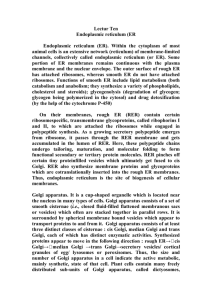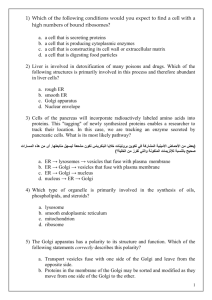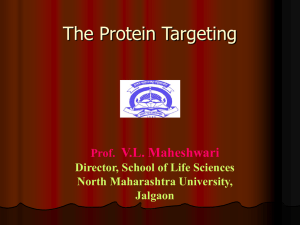U - Biology Department
advertisement
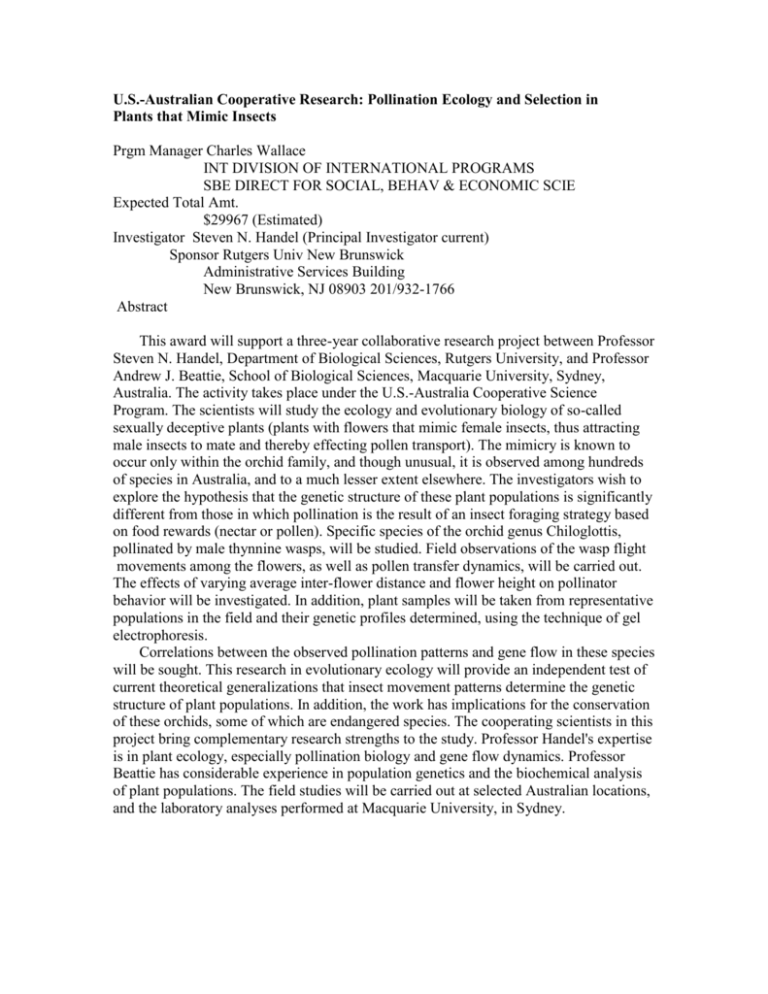
U.S.-Australian Cooperative Research: Pollination Ecology and Selection in Plants that Mimic Insects Prgm Manager Charles Wallace INT DIVISION OF INTERNATIONAL PROGRAMS SBE DIRECT FOR SOCIAL, BEHAV & ECONOMIC SCIE Expected Total Amt. $29967 (Estimated) Investigator Steven N. Handel (Principal Investigator current) Sponsor Rutgers Univ New Brunswick Administrative Services Building New Brunswick, NJ 08903 201/932-1766 Abstract This award will support a three-year collaborative research project between Professor Steven N. Handel, Department of Biological Sciences, Rutgers University, and Professor Andrew J. Beattie, School of Biological Sciences, Macquarie University, Sydney, Australia. The activity takes place under the U.S.-Australia Cooperative Science Program. The scientists will study the ecology and evolutionary biology of so-called sexually deceptive plants (plants with flowers that mimic female insects, thus attracting male insects to mate and thereby effecting pollen transport). The mimicry is known to occur only within the orchid family, and though unusual, it is observed among hundreds of species in Australia, and to a much lesser extent elsewhere. The investigators wish to explore the hypothesis that the genetic structure of these plant populations is significantly different from those in which pollination is the result of an insect foraging strategy based on food rewards (nectar or pollen). Specific species of the orchid genus Chiloglottis, pollinated by male thynnine wasps, will be studied. Field observations of the wasp flight movements among the flowers, as well as pollen transfer dynamics, will be carried out. The effects of varying average inter-flower distance and flower height on pollinator behavior will be investigated. In addition, plant samples will be taken from representative populations in the field and their genetic profiles determined, using the technique of gel electrophoresis. Correlations between the observed pollination patterns and gene flow in these species will be sought. This research in evolutionary ecology will provide an independent test of current theoretical generalizations that insect movement patterns determine the genetic structure of plant populations. In addition, the work has implications for the conservation of these orchids, some of which are endangered species. The cooperating scientists in this project bring complementary research strengths to the study. Professor Handel's expertise is in plant ecology, especially pollination biology and gene flow dynamics. Professor Beattie has considerable experience in population genetics and the biochemical analysis of plant populations. The field studies will be carried out at selected Australian locations, and the laboratory analyses performed at Macquarie University, in Sydney. Mechanism of Protein Retention in the Golgi Apparatus Expected Total Amt. $300000 (Estimated) Investigator M. Gerard Waters (Principal Investigator current) Sponsor Princeton University Princeton, NJ 08544 609/452-3000 Abstract The secretory pathway of eukaryotic cells consists of a set of membrane-bounded compartments that are involved in delivery of newly synthesized proteins to their final destinations. The Golgi apparatus is involved in the post-translational modification and sorting of proteins that pass through it. The Golgi consists of several topologically distinct cisternae, each contains a unique set of resident proteins. These proteins resist dispersion by the large flux of vesicular traffic to and from the Golgi apparatus. The maintenance of the Golgi integrity is an essential process, yet it is poorly understood. Do newly synthesized Golgi proteins simply cease their forward movement upon reaching the correct cisternae, or do they localized by a more dynamic mechanism involving retrieval from distal compartments? The goal of this proposal is to gain insights into Golgi retention mechanisms. The budding yeast Saccharomyces cerevisiae is used as a model system since it is amenable to biochemical, cell biological, and genetic analyses. The Golgi mannosyltransferase, Och1p, will serve as the model protein because the inability to retain Och1p in the Golgi is readily detectable by both biochemical and genetic techniques. Fusion proteins of Och1p fused to the reporter protein invertase have been used in initial studies. Inclusion of a cleavage site specific for a late Golgi endoprotease, Kex2p, in some of the fusion proteins, allows monitoring of the release of the invertase moiety if the fusion protein reaches the distal compartments of the Golgi. Initial results from these studies imply that newly synthesized Och1p is not retained efficiently on its first passage through the Golgi apparatus, that is, Och1p moves to distal compartments and is retrieved. Retention in the Golgi apparatus is not a static process, but is dynamic, involving, apparently, both anterograde and retrograde vesicular transport. The mechanism of this process will be further investigated by identifying components o f the cellular machinery that retains Och1p and mediates its retrieval from distal compartments; by determining if Och1p recycles through the ER and the endosomes, as well as the Golgi, by using mutants that can "trap" recycling Och1p in the ER or divert it from the endosomes to the plasma membrane; and by biochemically characterizing the statically-retained form of Och1p. Known mutants of the retrograde vesicular traffic will be examined to study their impact on the recycling of Och1p through the Golgi. New components of the retrograde transport apparatus will be identified by selecting mutants defective in recovering Och1p from distal compartments. These mutants will be phenotypically characterized and the gene will be examined at the molecular level. Studying protein retention in the Golgi of S. cerevisiae will be relevant to Golgi retention processes in mammalian cells as well as to the maintenance of other organelles. Since there exist numerous examples of evolutionary conservation of biological processes among various species, these studies will help reveal how human cells maintain compartmentalization that is so critical to cell viability. %%% The secretory pathway of eukaryotic cells consists of a set of membrane-bounded compartments that are involved in delivery of newly synthesized proteins to their final destinations. The Golgi apparatus is involved in the post-translational modification and sorting of proteins that pass through it. The Golgi consists of several topologically distinct cisternae, each contains a unique set of resident proteins. These proteins resist dispersion by the large flux of vesicular traffic to and from the Golgi apparatus. The maintenance of the Golgi integrity is an essential process, yet it is poorly understood. Do newly synthesized Golgi proteins simply cease their forward movement upon reaching the correct cisternae, or do they localized by a more dynamic mechanism involving retrieval from distal compartments? The goal of this proposal is to gain insi ghts into Golgi retention mechanisms. Studying protein retention in the Golgi of S. cerevisiae will be relevant to Golgi retention processes in mammalian cells as well as to the maintenance of other organelles. Since there exist numerous examples of evolutionary conservation of biological processes among various species, these studies will help reveal how human cells maintain compartmentalization that is so critical to cell viability. *** Cloning of the TuMV Genome and Analysis of Its Movement Protein Expected Total Amt. $12000 (Estimated) Investigator Jerry L. Bryant (Principal Investigator current) Sponsor U of Missouri Saint Louis 8001 Natural Bridge Road Saint Louis, MO 631214401 314/553-0111 Abstract The proposed planning activity will enable the applicant to prepare a cDNA library of the Turnip mosaic virus and develop viral mutants and probes as well as other reagents required for a longer term research plan directed toward establishing the gene sequence, the protein structure and the function of the turnip mosaic virus movement protein. Turnip mosaic virus is a member of an agriculturally important and widespread group of plant viruses. These viruses occur worldwide and infect all vegetable and ornamental plants of the mustard and cress family. These viruses are transmitted by many species of aphid. When viruses are inoculated onto host plants, either by a feeding insect or by an abrasion, the initial infection is limited to a single or few cells of the plant. In order for the virus to successfully infect the entire plant, movement from cell to cell is necessary. This movement involves the plasmodesmata, which are membrane-lined pores extending through the cell walls and connecting adjacent plant cells. A virus-encoded factor termed the "movement protein" is also required. The movement protein of another plant virus has been shown to increase the effective size of the channels between cells, and this is thought to facilitate movement of virus from cell to cell. The movement protein of turnip mosaic virus probably has a similar function. The wide- ranging turnip mosaic virus and its movement protein are excellent candidates for genetic manipulation for crop protection, but the molecular biology of this system also has the potential for providing new information on the biology of plant-virus interactions, the structure and function of the plasmodesmata and the molecular biology of plant virus replication. The goal of the proposed planning activity is to lay the experimental groundwork for determining the structure of the gene encoding the turnip mosaic virus movement protein and ultimately studying its function. Biogenesis and Function of Cortical Granule Contents Expected Total Amt. $300000 (Estimated) Investigator Gary M. Wessel (Principal Investigator current) Sponsor Brown University 164 Angell Street Providence, RI 02912 401/863-1000 Abstract Cortical granules are secretory vesicles unique to eggs and oocytes. At fertilization they secrete their contents to form both a permanent block to polyspermy and to provide protection for early embryonic development. In this application we will address three questions: What is in the cortical granule?, What does it do?, and How does it get in there? We will use sea urchin eggs and oocytes to answer these questions because in this animal we can obtain approximately 106 eggs and 1 ~ oocytes per female, and because the approximately 15,000 cortical granules in each oocyte are synchronous in biogenesis, in translocation to the surface, in docking to the plasma membrane, and in secretion in response to sperm or parthenogenic activation. This system offers a unique opportunity to examine the molecular mechanism of cortical granule biogenesis and flinction. The sea urchin oocyte is also the only oocyte in which 1) cDNA clones have been isolated that encode content and membrane proteins specific to the cortical granules; 2) the cortical granules can be isolated in a fimctional form; and 3) in vitro culture and maturation of oocytes and direct visualization of cortical granules is possible. In addition to the synchrony of vesicle biogenic steps, cortical granules are different from most other secretory vesicles in that they are nonrecycling, and contain over a dozen different proteins that are specific to cortical granules and are subcompartmentalized within the vesicle. Three specific aims are proposed: 1. Identify the contents of the cortical granules. We will focus on the cDNA cloning of the three fertilization envelope proteins: proteohaisin, p90 and p63. These are major envelope proteins that must quickly interact with each other and with the vitelline layer to form an impenetrable layer within seconds of fertilization. 2. Characterize the function and regulation of the cortical granule proteins. We will determine the mechanism of fertilization envelope construction, a specialized extracellular matrix, by identiiying domains of cortical granule protein interactions that are responsible for envelope construction. We will then use this information to examine the hierarchy, and identity of interactions with the vitelline layer to understand the molecular mechanism for the rapid condensation of the fertilization envelope. 3. Determine how the contents are packaged selectively into cortical granules. We will make use of the newly identified cDNA clones to determine the mechanism of cortical granule biogenesis. Selective protein targeting into cortical granules will be studied using recombinant, tagged cortical granule proteins. The tags will include the myc epitope and the green fluorescent protein, and we will follow the fates of wild-type and modified cortical granule protein sequences during cortical granule biogenesis. We will also use these tagged proteins, in conjunction with biotinylated amino acid markers, to assay cortical granule biogenesis. Because of our recent success with in vitro maturation of sea urchin oocytes, we will also be able to study cortical granule protein function in vivo. Mechanisms and Integration of Signal Pathways: A Role for Calpains? Expected Total Amt. $300000 (Estimated) Investigator Dorothy E. Croall (Principal Investigator current) Sponsor University of Maine 5717 Corbett Hall Orono, ME 044695717 207/581-1110 Abstract Cells receive environmental signals which determine their development, growth and differentiation. How external signals transmit information to the nucleus to regulate these processes is a fundamental question of cell biology. The long range goal of this research is to understand the biochemical mechanisms that mediate cellular responses to these signals. This project focuses on the two calcium-dependent proteolytic enzymes, microand milli- calpain (EC 3.4.22.17), and a protein inhibitor that specifically inhibits them, calpastatin. These enzymes may play a direct role in calcium-linked signal pathways and also may mediate integration (cross-talk) between signalling pathways. The proteins susceptible to calpain represent each phase of signal transduction including receptors, kinases, phosphatases and transcription factors. It is not known whether these signalling components share common features that are recognized by calpain. These studies will characterize the substrate recognition determinants for calpains by 1) identifying the calpastatin binding site within calpain; 2) testing the hypothesis that either calmodulinbinding domains, PEST- regions, or both, mediate substrate recognition; and 3) analyzing the amino acid sequences surrounding calpain-cleavage sites within potentially, physiologically significant protein targets. Results of these studies will provide new approaches for experimental manipulation of calcium-linked signal pathways. Another objective is to discover how calcium regulates calpain activity. It is hypothesized that the regulation of calpain by calcium is analogous to calmodulin regulation of its target enzymes. A first step toward testing this hypothesis will be to examine the effects of calmodulin antagonists on calpain. Further tests of the hypothesis are envisioned, but are beyond the scope of this project. The results of these experiments should provide important insights towards a general understanding of how calcium regulates the functions of the proteins and enzymes that can bind calcium ion directly. %%% Cells receive environmental signals which determine their development, growth and differentiation. How external signals transmit information to the cell nucleus to regulate these processes is a fundamental question of cell biology. One major internal messenger in signaling is calcium. Intracellular calcium levels have been found to go up in response to a variety of signals in many types of cells, but the mechanisms by which calcium acts in various signaling pathways are not yet understood despite much research. This project focuses on two calcium-dependent enzymes that break down specific proteins, and an inhibitor that specifically inhibits them. These enzymes may play direct roles in calcium-linked signal pathways and also may mediate cross-talk between different signalling pathways. A primary goal of this research is to characterize the mechanisms by which the calcium- dependent enzymes recognize and act on other proteins in the signaling pathways. The results will be an important contribution to our understanding of the role of calcium in cellular signal transduction mechanisms.***




